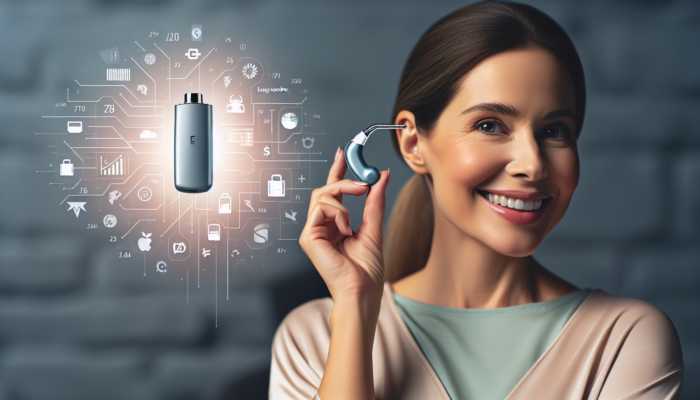Last Updated on 22/09/2025 by Admin
Discover the Advantages of Smart Hearing Aids for Enhanced Listening
What Are the Essential Features of Smart Hearing Aids?
Smart hearing aids signify a remarkable advancement in auditory technology, tailored to meet the diverse listening requirements of individuals worldwide. Unlike conventional hearing aids, these innovative devices utilize advanced electronics and software, providing enhanced auditory experiences that are both personal and intuitive. Smart hearing aids come with a variety of features that assist users in effectively navigating their acoustic environments. Notable features of smart hearing aids include:
- Adaptive sound settings that automatically adjust to different environments
- Connectivity options for streaming audio from smartphones, televisions, and other devices
- Noise reduction technologies that minimize distracting background sounds
- Personalized sound profiles tailored to individual hearing preferences
- Rechargeable batteries for user convenience
- Remote adjustment capabilities through smartphone applications
- Health monitoring features that track physical activity and provide alerts
- Virtual assistant integration for hands-free control
These features collectively enhance the listening experience by promoting a more customized approach to sound management. Consequently, users can relish clearer conversations, superior sound quality, and a more immersive auditory experience.
How Do Smart Hearing Aids Function Effectively?
Smart hearing aids operate based on sophisticated digital signal processing principles, enabling them to analyze and manipulate sound waves in real-time. These devices are engineered to capture a broad spectrum of sounds, processing them to enhance clarity and intelligibility. They leverage various technologies, allowing users to adapt effortlessly to different acoustic environments. The technologies employed in smart hearing aids include:
- Digital signal processing (DSP) for real-time sound enhancement
- Directional microphones that focus on sounds from specific directions
- Bluetooth connectivity for seamless integration with smartphones and other devices
- Artificial intelligence algorithms that learn and adapt to user preferences
- Environmental sensors that detect background noise levels
- Feedback cancellation systems to prevent whistling sounds
- Multi-channel sound processing for improved clarity across various frequencies
By employing these advanced technologies, smart hearing aids can dynamically adjust sound parameters, offering users an optimal listening experience tailored to their specific needs. This adaptability not only enhances sound quality but also enriches social interactions, enabling users to engage more fully in conversations across different settings.
What Are the Key Benefits of Using Smart Hearing Aids?
The advantages of utilizing smart hearing aids extend well beyond improved sound quality. Users experience a multitude of enhancements that can significantly elevate their quality of life. The primary benefits include:
- Superior sound quality, facilitating clearer conversations and improved enjoyment of music
- Enhanced connectivity, allowing direct audio streaming from devices
- Customization options tailored to individual listening preferences
- Greater independence through self-adjustable features and remote control
- Improved speech recognition in noisy environments
- Social engagement and enhanced relationships due to better communication
- Health tracking features that support overall well-being
- Reduced listening fatigue through advanced noise management
As users incorporate smart hearing aids into their daily routines, they frequently report increased participation in social activities and enhanced emotional well-being. Moreover, the ability to tailor sound settings to personal preferences leads to a more enjoyable auditory experience, fostering stronger connections with family, friends, and the broader world.
Insights from Experts on the Impact of Smart Hearing Aids on Listening Experiences
What Insights Do Experts Provide About Smart Hearing Aids?
Experts in the fields of audiology and hearing technology consistently highlight the transformative potential of smart hearing aids. They underscore how the integration of sophisticated algorithms and adaptive features significantly boosts user satisfaction. For instance, leading audiologists observe that users experience a noticeable improvement in their ability to comprehend speech, especially in complex acoustic environments. One expert affirms, “The advanced technology integrated into smart hearing aids allows for a tailored listening experience that was previously unattainable with traditional devices.”
Real-world examples further validate this perspective; users report increased confidence in social situations where background noise previously posed challenges. The capability of these devices to filter and enhance speech sounds ensures that conversations become clearer and more engaging. Moreover, experts agree that the ongoing evolution of smart hearing aids—driven by user feedback and technological advancements—will continue to refine their effectiveness in various listening scenarios.
How Do Smart Hearing Aids Enhance Listening Capabilities?
Smart hearing aids boost listening capabilities through advanced algorithms designed to process sound more effectively. They isolate and amplify speech while concurrently reducing distracting background noise. Users can maximize the benefits of these devices by implementing actionable strategies such as:
- Regularly updating the device software for optimal performance
- Adjusting personal sound profiles according to varying environments
- Utilizing smartphone apps for real-time adjustments and settings
- Employing directional microphone settings in noisy spaces
- Consulting with audiologists for personalized tuning
By adopting these strategies, users can significantly enhance their listening experiences, leading to more effective communication and an improved overall quality of life. Smart hearing aids are designed to adapt to diverse environments, allowing users to transition seamlessly from quiet settings to bustling public spaces without compromising sound quality.
What Are the Emerging Trends in Smart Hearing Aids?
The future of smart hearing aids is set to witness remarkable advancements, driven by continuous technological innovations. Predictions indicate that the integration of artificial intelligence will deepen, enhancing the personalization capabilities of these devices. Experts anticipate that future smart hearing aids will feature more discreet designs, making them less noticeable while still packed with functionality. Innovations in battery technology are also expected, leading to longer-lasting power sources and faster charging capabilities.
Additionally, increased connectivity with other smart devices is anticipated, paving the way for an interconnected auditory experience that seamlessly integrates into users’ daily lives. Experts assert that as technology continues to evolve, we will witness smarter hearing aids that not only enhance auditory experiences but also provide real-time feedback on environmental sounds, further enriching users’ listening encounters. As these trends unfold, they promise to redefine the boundaries of hearing assistance technology.
Latest Technological Innovations in Smart Hearing Aids
What Are the Cutting-Edge Technologies in Smart Hearing Aids?
The realm of smart hearing aids is rapidly transforming, with several cutting-edge technologies leading this evolution. These advancements aim to deliver superior user experiences and improve auditory outcomes. Notable technologies include:
- AI-driven sound processing that adapts to the user’s unique listening preferences
- Wireless connectivity options allowing for seamless integration with various devices
- Rechargeable battery systems promoting convenience and sustainability
- Real-time environmental analysis that dynamically optimizes sound settings
- Telehealth capabilities enabling remote adjustments and consultations
- Health monitoring features that track metrics such as physical activity and steps
- Personalized sound adjustment features based on user feedback and preferences
- Feedback cancellation technologies that eliminate whistling and distortion
These advancements not only enhance the functionality of smart hearing aids but also foster user engagement with their devices. By incorporating the latest technologies, manufacturers are addressing common challenges faced by hearing aid users, ultimately leading to a more satisfying listening experience.
How Do Smart Hearing Aids Adjust to Various Environments?
Smart hearing aids exhibit a remarkable ability to adapt to different listening environments, a process powered by sophisticated sensors and algorithms. These devices continuously monitor their surroundings, adjusting sound parameters to optimize the listening experience. For instance, in a noisy restaurant, smart hearing aids can identify elevated background noise levels and automatically switch to a setting that enhances speech clarity, allowing users to concentrate on conversations without straining.
The mechanisms that enable this adaptability include:
- Directional microphones that focus on sounds from specific angles
- Environmental sensors that assess noise levels and sound quality
- Machine learning algorithms that learn from user preferences over time
- Real-time sound processing that adjusts settings on-the-fly
- Feedback systems that prevent distortion and whistling
This level of responsiveness not only enriches the listening experience but also empowers users to engage more actively in diverse social scenarios. Whether in quiet settings or bustling environments, smart hearing aids provide an unprecedented level of auditory clarity and comfort.
What Role Does AI Play in Smart Hearing Aids?
Artificial intelligence plays a crucial role in enhancing the functionality of smart hearing aids, enabling users to benefit from personalized auditory experiences. AI algorithms analyze sound data in real-time, allowing these devices to differentiate between various sounds and prioritize speech over background noise. This capability significantly improves listening quality, especially in challenging acoustic environments, such as crowded places or social gatherings.
The role of AI in smart hearing aids encompasses several key aspects:
- Adaptive sound processing that learns user preferences and adjusts settings accordingly
- Noise reduction technologies that intelligently filter out unnecessary background sounds
- Speech enhancement features that amplify vocal frequencies for improved clarity
- Contextual awareness allowing the device to determine the most beneficial sound settings
- Continuous learning capabilities that refine performance based on user interactions
As AI technologies continue to evolve, the potential for smarter hearing aids becomes even greater, paving the way for innovations that will further enhance listening experiences. Users can anticipate devices that not only respond to their immediate needs but also evolve in understanding and performance over time.
How Do Smart Hearing Aids Improve Speech Clarity?
What Technologies Are Designed to Enhance Speech Clarity in Smart Hearing Aids?
Smart hearing aids utilize various advanced technologies specifically tailored to enhance speech clarity, ensuring users can engage in conversations without difficulty. Directional microphones represent one of the most effective solutions; they are engineered to capture sound from specific directions while minimizing the influence of surrounding noise. This technology is particularly valuable in settings with multiple competing sounds, enabling users to focus on the voices of those they wish to hear.
Other technologies that contribute to enhanced speech clarity include:
- Noise reduction algorithms that filter out distracting sounds
- Multi-channel sound processing which allows distinct frequencies to be amplified differently
- Real-time sound adjustment features that adapt to changing environments
- Feedback cancellation systems that eliminate unwanted whistling sounds
These technological innovations work collaboratively to create a listening experience that prioritizes speech, allowing users to maintain meaningful conversations even in challenging auditory landscapes. As users become more accustomed to these enhancements, they report greater confidence and satisfaction in their ability to communicate effectively.
How Do Smart Hearing Aids Effectively Reduce Background Noise?
Reducing background noise is a fundamental function of smart hearing aids, achieved through advanced algorithms that identify and suppress unwanted sounds. These devices employ several specific techniques to ensure users can concentrate on speech rather than distractions. For instance, smart hearing aids often utilize adaptive filtering, which dynamically adjusts the sound input based on the environment’s noise profile.
The techniques used to minimize background noise include:
- Directional microphone technology that focuses on sound coming from in front of the user
- Dynamic noise reduction algorithms that continuously analyze and suppress background sounds
- Environmental adjustments that recalibrate settings based on the level of surrounding noise
- Volume adjustments that allow users to set preferred levels for different acoustic environments
By implementing these methods, smart hearing aids help create a more serene listening environment, allowing users to engage in conversations, enjoy music, or participate in social activities with minimal interference from distracting sounds. This capability significantly enhances the overall listening experience, leading to greater user satisfaction and engagement.
What Are the User Experiences with Enhanced Speech Clarity?
Users consistently report notable improvements in their ability to understand speech when utilizing smart hearing aids. This enhancement not only facilitates better communication but also fosters deeper social connections and interactions. Many individuals express their satisfaction by highlighting the clarity they experience in diverse settings, such as family gatherings, restaurants, or public events.
Personal accounts emphasize how improved speech clarity leads to positive changes in communication dynamics. Users frequently mention feeling less strained during conversations, as they can focus on the speaker without the distraction of background noise. They describe their experiences as more engaging and meaningful, stating that they can participate actively rather than feeling like passive listeners.
As users embrace these advancements, they report an enhanced quality of life, characterized by enriched social interactions and a renewed sense of confidence in their communication abilities. The improvement in speech clarity provided by smart hearing aids allows for more fulfilling relationships and an overall increase in social engagement.
How Do Smart Hearing Aids Adapt to Various Listening Environments?
The adaptability of smart hearing aids to different listening environments is one of their standout features, allowing users to enjoy superior sound quality across diverse settings. These devices are engineered to automatically adjust their settings based on real-time assessments of the surrounding environment. For example, in a quiet room, the hearing aids may optimize settings for softer sounds, while in a noisy café, they would shift focus to enhance speech clarity amidst the background clamor.
Mechanisms that facilitate this adaptability include:
- Integrated environmental sensors that detect sound levels and types
- Adaptive algorithms that adjust frequency responses based on the detected environment
- Context-aware settings that change automatically as users move through different settings
- User-defined preferences that allow for manual adjustments when necessary
These features enable users to experience seamless transitions between environments without the need for constant manual adjustments. By ensuring that each listening situation is optimized, smart hearing aids provide a consistently enjoyable auditory experience, enhancing the user’s ability to engage fully in conversations, regardless of their surroundings.
Connectivity Features of Smart Hearing Aids: Empowering Your Audio Experience
What Devices Can Smart Hearing Aids Connect To for Enhanced Functionality?
Smart hearing aids offer remarkable connectivity, enabling users to link their devices to a variety of technologies for an enriched auditory experience. This ability to connect with different devices enhances user convenience and opens up new avenues for audio consumption. The devices that smart hearing aids can seamlessly connect to include:
- Smartphones for direct audio streaming and control
- Televisions for a seamless viewing experience
- Tablets and computers for multimedia enjoyment
- Smart speakers and home assistants for voice-activated commands
- Fitness trackers for health monitoring
- Assistive listening devices designed for specific environments
- Remote microphones for improved sound capture in group settings
This level of connectivity transforms how users experience sound, allowing them to enjoy music, watch television, and engage with technology in a manner that is both convenient and effective. With the capacity to stream audio directly into their hearing aids, users can anticipate a more immersive experience that enhances both entertainment and communication.
How Do Smart Hearing Aids Utilize Bluetooth Technology for Enhanced Connectivity?
Bluetooth technology plays a pivotal role in the functionality of smart hearing aids, enabling users to stream audio wirelessly from various devices. This capability not only enhances convenience but also significantly improves the overall listening experience. Through Bluetooth, users can connect their hearing aids to smartphones, facilitating hands-free calls and direct audio streaming from music and podcast applications.
The benefits of Bluetooth technology in smart hearing aids include:
- Wireless audio streaming that eliminates the need for cumbersome wires
- Remote control features that allow users to adjust settings from their smartphones
- Seamless integration with other Bluetooth-enabled devices for enhanced usability
- Access to smartphone applications for personalized sound adjustments and feedback
By leveraging Bluetooth technology, smart hearing aids foster a more connected lifestyle, allowing users to enjoy richer auditory experiences without the limitations often associated with traditional hearing aids. The convenience of wireless connectivity encourages greater engagement with technology, ultimately leading to improved communication and entertainment opportunities.
What Are the Advantages of Wireless Connectivity in Smart Hearing Aids?
Wireless connectivity in smart hearing aids offers a multitude of advantages that significantly enhance the user experience. By enabling seamless audio streaming and remote adjustments, these hearing aids provide an unparalleled level of convenience and versatility. The advantages of wireless connectivity include:
- Elimination of wires, allowing for greater freedom of movement
- Real-time adjustments to sound settings via smartphone applications
- Easy access to audio content from various devices without needing to change settings manually
- Enhanced social interactions through hands-free calling features
This technology not only enriches how users interact with their hearing aids but also integrates their auditory experiences into a broader technological ecosystem. By embracing wireless connectivity, users can enjoy a more personalized and streamlined listening experience, which ultimately contributes to improved communication and social engagement.
Research-Backed Benefits of Smart Hearing Aids on Listening Enhancement
What Does Current Research Indicate About Smart Hearing Aids and Listening?
Numerous studies have demonstrated the profound impact that smart hearing aids have on listening capabilities and overall communication satisfaction. Research indicates that these devices significantly improve speech understanding in various environments, which is essential for effective communication. For instance, studies reveal that users of smart hearing aids report enhanced clarity in conversations, particularly in noisy settings where traditional hearing aids may falter.
Research data shows improved outcomes in speech recognition scores and heightened user satisfaction ratings among those utilizing smart hearing aids. Users often express that their ability to engage in social situations has dramatically increased, contributing to a more fulfilling lifestyle. The evidence underscores how the technology embedded in smart hearing aids addresses the unique challenges faced by individuals with hearing loss, ultimately leading to better auditory outcomes.
How Do Smart Hearing Aids Affect Quality of Life Positively?
The impact of smart hearing aids on quality of life is substantial, with users reporting enhanced communication abilities and improved social interactions. By facilitating clearer conversations, these devices contribute to a greater sense of connection with family, friends, and the community. Users often express that their confidence in social settings has increased, allowing them to engage more fully in activities they previously found challenging.
Expert analyses highlight that improved communication leads to better emotional well-being and social integration, which are critical components of quality of life. Individuals who use smart hearing aids frequently report higher levels of satisfaction in their daily activities, including work and leisure pursuits. As such, the positive ripple effects of using smart hearing aids extend beyond mere auditory improvements, significantly enriching users’ overall life experiences.
What Are the Long-Term Benefits of Consistent Use of Smart Hearing Aids?
Long-term use of smart hearing aids presents several significant benefits, particularly concerning cognitive function and overall health. Users who consistently wear these advanced devices are more likely to experience stable hearing and, in some cases, a slowdown in the progression of hearing loss. Research suggests that by enabling better communication, smart hearing aids can mitigate the risk of social isolation and associated cognitive decline.
Real-world examples illustrate the long-term advantages of smart hearing aids; individuals report sustained improvements in their ability to engage with others and participate in activities that promote cognitive health, such as reading or group discussions. Furthermore, users often experience enhanced emotional well-being, leading to increased satisfaction in relationships and everyday interactions. The long-term benefits of smart hearing aids reinforce their value not merely as auditory devices but as essential tools for fostering a healthier, more connected life.
Customization and Personalization of Smart Hearing Aids for Optimal Performance
How Can Users Customize Their Smart Hearing Aids?
Customization is a hallmark of smart hearing aids, enabling users to tailor their auditory experiences to match individual preferences and listening environments. These devices offer a variety of customizable features that enhance comfort and usability. Users can customize their hearing aids through:
- Adjustable sound settings that adapt to personal preferences and environments
- Personalized sound profiles created during professional fittings
- User-controlled features that allow for manual adjustments via smartphone apps
- Automatic adjustments based on environmental conditions and user feedback
This level of customization ensures that users can optimize their hearing aids for various situations, enhancing their overall listening experience. The ability to fine-tune settings according to personal needs fosters greater satisfaction and encourages consistent use, ultimately leading to improved communication and social engagement.
What Advantages Do Personalized Sound Profiles Offer?
Personalized sound profiles represent a significant advancement in smart hearing aids, enabling users to achieve optimal sound quality tailored to their specific hearing needs. These profiles allow for adjustments that enhance listening comfort and clarity, catering to unique auditory preferences. The key benefits of personalized sound profiles include:
- Improved sound quality tailored to individual hearing loss patterns
- Enhanced speech intelligibility in various environments
- Greater comfort during prolonged use
- Increased user satisfaction and confidence in communication
By utilizing personalized sound profiles, users can experience a dramatic improvement in their auditory experiences, leading to more meaningful interactions and a deeper connection to their surroundings. This tailored approach to sound management empowers users to take control of their listening environments, enhancing both their enjoyment and engagement in everyday activities.
How Do Smart Hearing Aids Adapt to the Preferences of Users Over Time?
Smart hearing aids are designed to learn and adapt to users’ preferences over time, creating a highly personalized auditory experience. This adaptability is achieved through sophisticated algorithms that analyze user interactions and feedback, enabling the devices to adjust settings autonomously. For example, if a user consistently modifies the volume in specific situations, the hearing aids can learn to adjust accordingly in similar environments in the future.
The mechanisms that allow these devices to adapt to user preferences include:
- Machine learning algorithms that analyze user behavior and feedback
- Data collection on user adjustments to fine-tune performance
- User-defined settings that can be saved and recalled automatically
- Contextual awareness that enables adjustments based on environmental changes
This adaptive capability not only enhances user satisfaction but also promotes ongoing engagement with the devices, encouraging consistent usage and maximizing the benefits of smart hearing aids. As users become more accustomed to their personalized settings, they can enjoy a richer and more fulfilling auditory experience.
How Do Smart Hearing Aids Excel in Noisy Environments?
What Technologies Are Effective in Managing Noisy Environments?
Navigating noisy environments can be particularly challenging for individuals with hearing loss, but smart hearing aids are equipped with technologies specifically designed to address this issue. These devices incorporate several advanced features that facilitate clearer listening amid background noise. Key technologies that aid users in noisy environments include:
- Directional microphones that capture sounds from specific locations
- Dynamic noise cancellation algorithms that filter out unwanted background sounds
- Automatic environmental adjustments that optimize sound settings for clarity
- Speech enhancement features that amplify vocal frequencies
By leveraging these technologies, smart hearing aids enable users to focus on desired conversations while mitigating the distracting effects of surrounding noise. This functionality is particularly beneficial in social situations, such as crowded restaurants or busy outdoor events, allowing users to engage more fully and comfortably in conversations.
How Do Smart Hearing Aids Improve Listening in Crowded Settings?
In crowded environments, smart hearing aids utilize advanced algorithms to prioritize speech clarity while minimizing background noise. These devices are designed to enhance the listening experience, enabling users to communicate effectively even in challenging auditory settings. Specific features that assist in crowded places include:
- Multi-channel sound processing that isolates speech from other sounds
- Adaptive filtering that adjusts based on the level of background noise
- Directional microphone technology that focuses on the speaker’s voice
- Environmental recognition that automatically adjusts settings for optimal clarity
These capabilities allow users to enjoy meaningful conversations, reducing the frustration often associated with background noise. By enhancing listening performance in crowded environments, smart hearing aids promote social interaction and boost users’ confidence in engaging with others.
What Are Users’ Experiences in Noisy Settings?
Users’ experiences in noisy settings significantly improve with the use of smart hearing aids, leading to enhanced speech understanding and reduced listening effort. Many individuals share positive feedback about their ability to participate in social gatherings, business meetings, and other group activities without the strain they previously encountered. Users report feeling more engaged and less fatigued as they navigate complex auditory environments.
Personal testimonials reflect how the technology in smart hearing aids transforms challenging listening situations into opportunities for meaningful connections. This improvement fosters a greater sense of belonging and social interaction, contributing to overall emotional well-being. As users become more comfortable communicating in noisy settings, their confidence and enjoyment in social activities increase, leading to enhanced quality of life.
How Do Customizable Settings Enhance Listening in Noisy Environments?
Customizable settings in smart hearing aids play a crucial role in optimizing listening experiences in noisy environments. Users can adjust their hearing aids according to their specific needs and preferences, enabling a more tailored approach to sound management. Features that enhance listening in noisy situations include:
- User-adjustable volume settings that allow for precise control
- Customizable noise reduction levels based on personal comfort
- Directional microphone settings that can be fine-tuned for various situations
- Pre-set environments designed for common listening scenarios, such as restaurants or outdoor settings
By utilizing these customizable options, users can adapt their hearing aids to suit their current environment, significantly improving speech clarity and overall listening comfort. This flexibility empowers users to navigate complex auditory landscapes with ease, enhancing their ability to engage in conversations and enjoy social interactions.
Essential Maintenance and Care for Smart Hearing Aids
How to Properly Maintain Your Smart Hearing Aids?
Maintaining smart hearing aids is crucial for ensuring optimal performance and longevity. Regular care practices can help users maximize the functionality and comfort of their devices. Key maintenance tips include:
- Cleaning the hearing aids regularly to prevent the buildup of earwax and debris
- Storing them properly in a protective case when not in use
- Replacing batteries on schedule, or ensuring rechargeable models are charged
- Scheduling regular check-ups with an audiologist for professional maintenance
By implementing these maintenance practices, users can ensure their smart hearing aids continue to deliver high performance and enhance their listening experiences for years to come. Proper care not only extends the lifespan of the devices but also contributes to consistent user satisfaction and effective communication.
Frequently Asked Questions (FAQs)
What are smart hearing aids?
Smart hearing aids are advanced devices designed to improve hearing by utilizing technology for better sound processing, customization, and connectivity.
How do smart hearing aids enhance listening?
They enhance listening through adaptive sound processing, noise reduction, and personalization features that prioritize speech clarity in various environments.
What technologies are used in smart hearing aids?
Smart hearing aids incorporate technologies like directional microphones, Bluetooth connectivity, AI algorithms, and real-time sound processing to optimize listening experiences.
Can smart hearing aids connect to smartphones?
Yes, smart hearing aids can connect to smartphones and other devices via Bluetooth, allowing for audio streaming and remote control of settings.
How do personalized sound profiles work?
Personalized sound profiles are tailored settings that adjust the hearing aid’s performance based on individual hearing needs, improving sound quality and comfort.
What are the benefits of using smart hearing aids?
Benefits include improved speech clarity, better social interactions, enhanced sound quality, and features that promote user convenience and satisfaction.
How do smart hearing aids perform in noisy environments?
Smart hearing aids use directional microphones and noise reduction algorithms to enhance speech clarity while minimizing background noise in noisy settings.
What is the role of AI in smart hearing aids?
AI enhances smart hearing aids by enabling adaptive sound processing, learning user preferences, and improving overall auditory experiences in various environments.
How can users maintain their smart hearing aids?
Users can maintain their smart hearing aids through regular cleaning, proper storage, timely battery replacements, and professional check-ups.
What is the impact of smart hearing aids on quality of life?
Smart hearing aids significantly improve users’ quality of life by enhancing communication, reducing social isolation, and fostering better engagement in daily activities.
Explore our world on X!
The post Smart Hearing Aids: Elevate Your Listening Experience appeared first on The Microsuction Ear Wax Removal Network.













